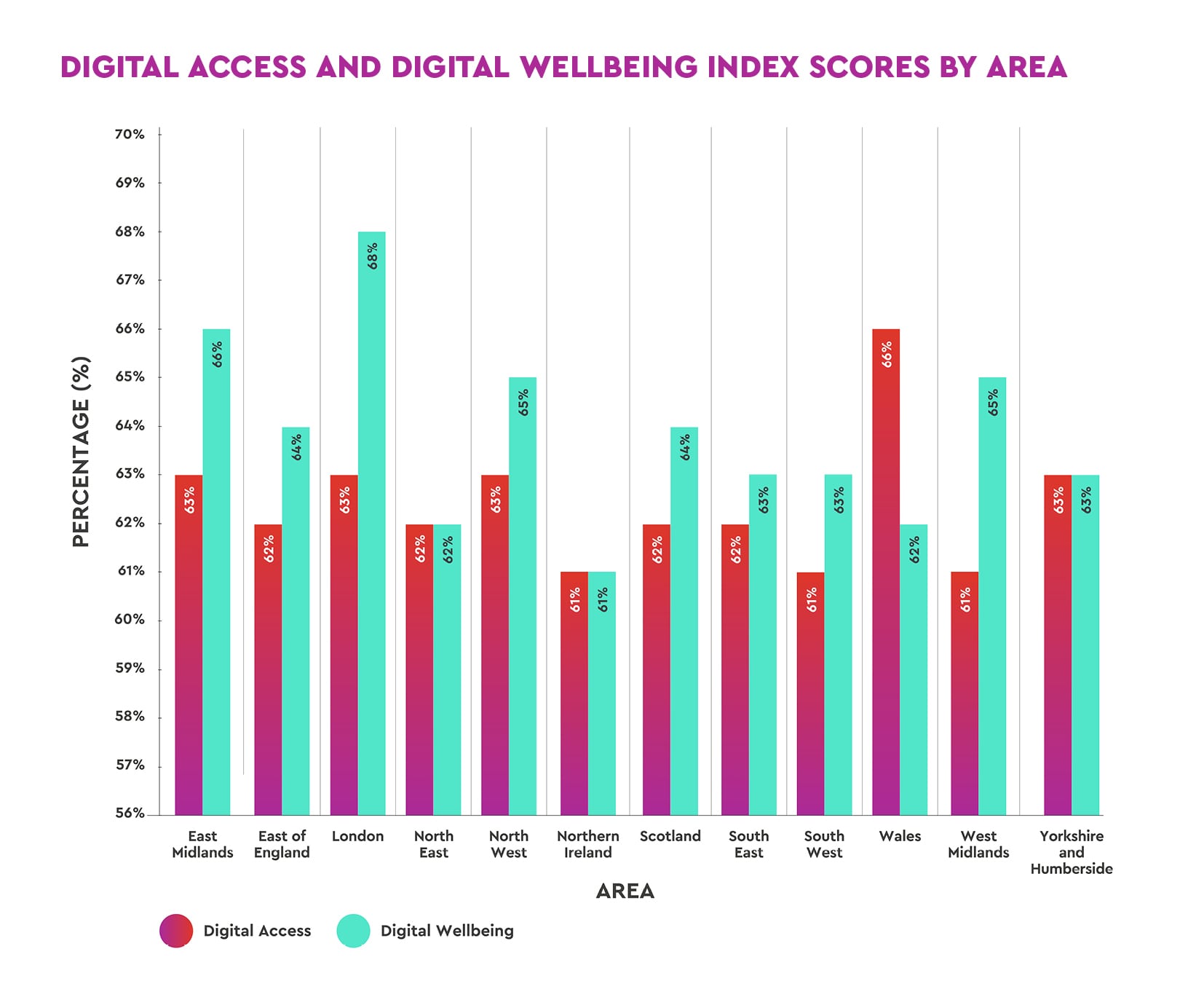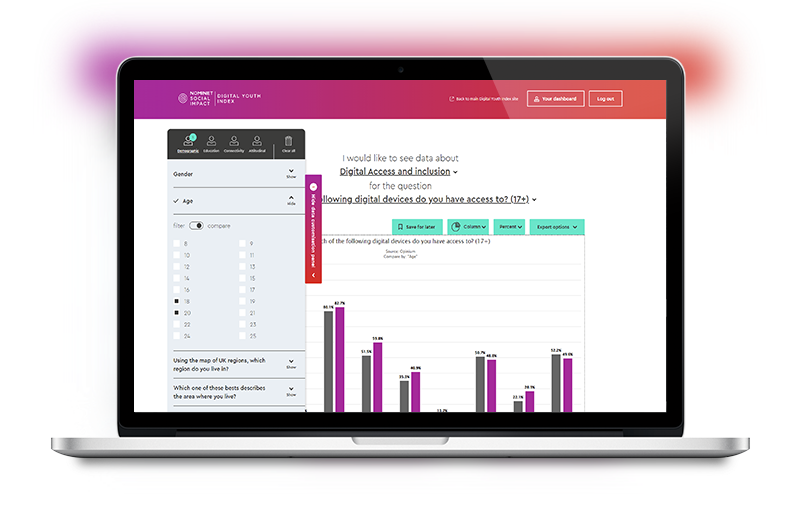When we look across the five pillars of the Digital Youth Index, our 2022 data clearly highlights two critical areas which need addressing: Digital access (62%) and digital wellbeing (64%), where the index scores for both fall below the overall index score of 71% at a national level.
In this article, we’re going to delve deeper into these pillars, looking at the young people who are most impacted and sharing some thoughts around any correlating factors between the two.
The digital access pillar refers to the access and use of a ‘critical’ digital device by a young person. The digital wellbeing pillar encompasses how much a young person feels in control of what they see and do online, how much time they spend on digital devices and the impact of these on their life.
Young people with disabilities score lower for digital access and digital wellbeing
The Index shows there is a link between disability and poor digital access (61% vs. 64% for young people without a disability). Young people with a disability are also more likely to have poor digital wellbeing (63% vs. 66% for young people without a disability), with lower scores becoming more apparent among young people with a disability relating to their mental health (60%), learning difficulties (61%) and social or behavioural conditions such as autism (63%).
While being online is often conceived as a positive and rewarding experience by young people[2] and many find it fun, entertaining and inspiring, there are some young people who experience more negative emotions when spending time online, impacting their digital wellbeing.
As part of our survey research for the Index, young people often mentioned that they thought teenagers (and older teenagers) were more likely to be unhappy online[2], as well as any young people experiencing comparison online or being targeted for criticism, both of which are likely to be common in the teenage age group.
Young people in the LGBTQ+ community have lower digital wellbeing (59%) than young people who identify as heterosexual/straight (66%).
Many teachers also mentioned mental health being something that they see significantly impacting young people in schools, particularly when it comes to social media.[2]Themes around this included social issues becoming more intense due to their link to social media activity and mental health struggles being intensified by the use of social media apps in young people.
In fact, young women/girls are more impacted by digital wellbeing compared to young men/boys (62% vs. 67%). However, when we look at digital access, young men/boys are more impacted compared to young women/girls (60% vs. 65%).
Digital access and wellbeing scores improve when chief income earners hold a formal qualification
Young people living in households where the chief income earner has a formal qualification score higher for digital access. This might relate to affordability of devices, having a digital device at home for work purposes, and digital knowledge.

This is also the case for digital wellbeing, with the score increasing among young people living in households where the chief income earner holds a professional qualification (70% vs. 62% for those without a professional qualification).
Young people living in households where the chief income earner is unemployed or working class tend to have poorer digital access (61% vs. 64% of young people living in middle class households).
Lower income households have poorer digital access (57%) compared to those in the upper income tier (68%).
While there is room for improvement at both extremes, access to digital devices for lower income households needs prioritising to ensure young people aren’t at a disadvantage to their peers with higher access scores.
However, there is no significant difference when we look at digital wellbeing by social grade, with those living in middle class households scoring only slightly higher than those from working class/unemployed households (65% vs. 64%).
Cost-of-living crisis is impacting both digital access and wellbeing
The cost-of-living crisis appeared to have impacted digital access at the time of our 2022 research, with those not impacted at the time having an overall digital access score of 66%, while those struggling to pay bills or being unable to replace or fix a broken device scoring around 61%.
The cost-of-living crisis also appeared to be a contributing factor to digital wellbeing, showing those who at that point in time had not been impacted by the crisis having a combined wellbeing score of 68% compared to those with money worries having a score of 60%.
This suggests when the 2022 research was conducted, at the start of the cost-of-living crisis, it was impacting the ability to purchase, fix and update digital equipment, alongside affecting the overall sense of wellbeing in young people, including their digital wellbeing. With the cost-of-living crisis continuing to impact many families and young people in the UK, it is likely this will be even more heightened now.
Young people living in urban areas have higher scores for digital access and digital wellbeing
Young people living in rural areas are more likely to have poorer digital access (61%) compared to those living in urban (62%) and suburban (63%) areas.
Although this difference is only slight, it also seems the case when looking at digital wellbeing, with young people in rural areas scoring lower (62%) compared to suburban (63%) and urban (67%).
Northern Ireland has the lowest score for both digital access (61%) and digital wellbeing (61%).
The areas least affected (but still having low scores) for digital access are Wales (66%) and the North West (63%). Interestingly, Wales is the only area where digital access scores higher than digital wellbeing.
For digital wellbeing, London has the highest score (68%) with East Midlands following (66%). London is also the area where digital wellbeing is significantly higher compared to digital access, although this is apparent across all other areas apart from Wales.

You can delve deeper into these findings and explore scores and insightful data across all five pillars of the Index with our data tool.
[2] Qualitative research with young people, parents, secondary school teachers and social and youth workers as part of the 2022 Index data.
Share this article









